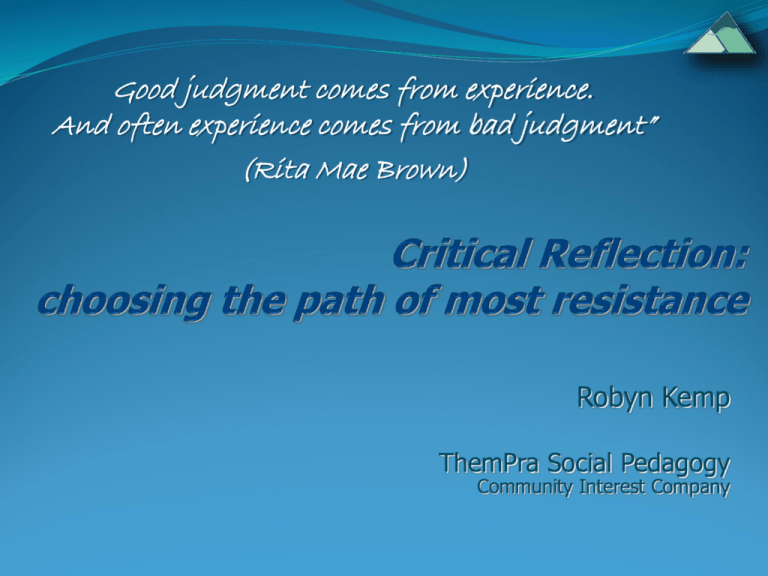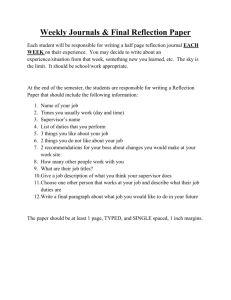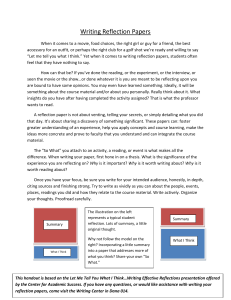PowerPoint Version - Unity Through Relationship
advertisement

Good judgment comes from experience. And often experience comes from bad judgment” (Rita Mae Brown) Robyn Kemp ThemPra Social Pedagogy Community Interest Company Social Pedagogy & critical reflection: an historic and a contemporary partnership 18th century Johann Pestalozzi – observation and reflection as essential components of the education of head, heart and hands 19th century, Karl Mager – social pedagogy as ‘the theory of all the personal, social and moral education in a given society’ Friedrich Diesterweg – ‘It forbids: arbitrary assumptions and manipulations of human nature; any encouragement to act blindly and mechanically; any kind of drill; rote learning; uniformity; force-feeding with subject matter that is not understood etc.’ 20th century, Paulo Freire – promoted praxis (action that is informed) and the ‘problem-posing’ concept of education: ‘must abandon the educational goal of deposit-making and replace it with the posing of the problems of human beings in their relations with the world.’ SCIENCE Academic discipline Branch of research EDUCATION PRACTICE Profession Prof Hamalainen, 2014, Developing Modern Social Pedagogy Badry & Knapp, 2003 Defining Critical Reflection Oxford English Dictionary Reflection - ‘Serious thought or consideration ’ Critical – ‘Involving the objective analysis and evaluation of an issue in order to form a judgement ’ UK descriptions of critical reflection Jan Fook and Fiona Gardner, 2007 ‘unsettling individual assumptions to bring about social changes. Emphasises that: Reflection is deeper than popular notions of thinking Critical reflection is based on an understanding of the individual in societal context and links between the individual and society Critical reflection is both a theory and a practice Critical reflection links changed awareness with changed action’ (p16) UK descriptions of critical reflection Gillian Ruch, 2007 ‘Critical reflection … seeks to transform practice by challenging the existing social, political and cultural conditions that promote certain ‘constitutive interests’ at the expense of others and the structural forces that distort or constrain professional practice.’ (p661) Neil Thompson, 2008 ‘looking beneath the surface of the presenting problem and situation (critical depth), and more widely at the social circumstances in which practice is taking place (critical breadth)’. (p1) Contexts of social pedagogy and critical reflection Societal Geographical, Political, Social, Cultural, Economic Institutional, Organisational Empowerment Power? Participation Control ? Rights Dominance ? Learning Individual Influence? Relationships 1. Professional responsibility Centrality of ethical practice in social pedagogy Code of SW ethics, Ireland & UK Respect for the inherent dignity and worth of persons / human rights (UK) Pursuit of social justice (UK) Integrity of professional practice / professional integrity (UK) Confidentiality & competence in professional practice We have power and must understand and use it responsibly 2. To learn, adjust & develop The Learning Zone Model, Senninger (2000) 3. Lazy brains! The human condition is predisposed to take the path of least resistance Automaticity ‘the control of one's internal psychological processes by external stimuli and events in one's immediate environment, often without knowledge or awareness of such control…, despite good intentions’, Bargh & Williams, 2006:1 Social constructivism ‘we don’t see the world as it is, we see it as we are’ Anais Nin ‘the hearer, not the speaker, determines the meaning’ Heinz Von Foerster Some societal level influences Neoliberalism: ‘a theory of political economic practices that proposes that human well-being can be best advanced by liberating individual entrepreneurial freedoms and skills within an institutional framework characterised by strong private property rights, free markets and free trade’ (Harvey, 2005:2). Consumerism: the promotion of the consumer’s interests; the theory that an increasing consumption of goods is economically desirable; a preoccupation with and an inclination toward the buying of stuff and things Individualism: favouring freedom of action for individuals over collective or state control. Communication: emails, video conferencing, social networks And more… Some institutional level influences New Public Management – emphasis on the 3Ms: Markets: free trade in public services; commodification of children Managers: top down managerialism, increased bureaucracy Measurements: outcomes/target-driven policy & practice Recession & austerity: increased need vs decreasing funds Dominance of certain theoretical perspectives, e.g. attachment, behaviourism Reductionism, simplification – ‘social workers should do the simple things properly’ Laming, 2003 Individual level influences Individual level influences Personal Private Professional Other’s needs Others & own needs Own needs Some individual level influences Organisational targets, goals, values, preferences Culture, leadership styles, systems, structures, methods and practices Workforce morale, perceptions of own and others’ power, status, position “first, cover your back” Organisational and personal image of the child and social welfare client Physical and emotional states, e.g. hunger, fatigue, stress Own experiences, values, cultures, prejudices, assumptions, preferences Our ability to observe without judgement And more… How can we develop as critically reflective practitioners, organisations and educationalists? The learning zone and the sea Social pedagogical approach to critical reflection Central values include Equality, Respect, Empathy, Curiosity Process of deconstruction for holistic scrutiny Actively concerned with the relational Asks critical questions, analyses assumptions, challenges prejudices Participants are open to: New information & learning Accommodating a range of perspectives alongside own Making and owning mistakes Letting go of old ideas Sitting with uncertainty & complexity Culminates in identifying learning and the associated necessary changes to practice Critical Topics & Questions Power – who has it, who doesn’t, who wants/needs more? the most common way people give up their power is by thinking they don’t have any – Alice Walker Why were certain theories, models or methods chosen? Whose perspective dominates and why? Joy (is relational vitamins, Berit Bae) – how does the person experience joy, what opportunities have been created? How have I listened? Have I fully utilised all my senses? How could relationships be affected by this course of action? What damage /unintended consequences could result? What roles do optimism and hope play in how we are talking and thinking about this person/case? I have learned over the years that when one’s mind is made up, this diminishes fear Rosa Parks References Fook & Gardner, 2008 Ruch 2007, 2011 Thompson 2008 Mager, 1844 Friere, 1970 Bargh & Williams Kahneman Ordonez, Schweitzer, Galinsky, Braverman (2009) harvard business school, Goals gone wild: the systemic side effects of over prescribing goal setting, working paper no 09-083, feb 2009






